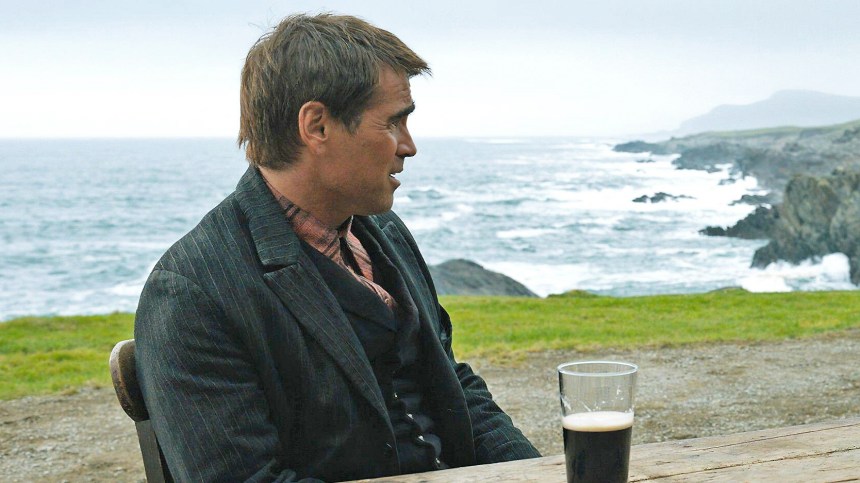By Cara Crofts
“The next parish over is Boston,” the locals of the Aran Islands will proudly tell you. They are the edge of civilisation this side of ‘The Pond’ and like it that way. For the most part. Suspended off the west coast of Ireland, three limestone slabs are the foundations for life in a world outside of time; a far cry from Boston’s big city lights. American filmmaker Robert Flaherty was enchanted by the primitive lifestyle of the Aran Islands in 1934, fetishizing the fight between islanders and nature in his fictional documentary Man of Aran. The sea is strong but the community spirit is stronger – this romanticised portrayal doesn’t survive Martin McDonagh’s The Cripple of Inishmaan. The play satirises the real-life filming of Man of Aran and Flaherty’s sentimentalised documentary, instead exposing the boredom and cruelty which breed in such a tight-knit community. “Cripple” Billy’s attempt to escape to Hollywood fails but, in The Banshees of Inisherin, McDonagh writes a way out for Siobhán (Kerry Condon) whose future teaching on the mainland frees her from her claustrophobic life. She urges her brother that on Inisherin there will be “nothing but more bleakness and grudges and loneliness and spite and the slow passing of time until death.” We can’t help hoping Pádraic (Colin Farrell) will join Siobhán but it is no surprise when he insists his life is on Inisherin. For him, nowhere but this secluded island could be home.
A misshapen scrabble board of rocky fields. Calm waters stretch to the mainland. Folk music swells as the mist rises over McDonagh’s fictional island of Inisherin, inspired by the Aran Island of Inisheer. You could be forgiven for expecting a film of sunshine and rainbows as Colin Farrell strides through the port in this opening scene, framed by a saturated rainbow while he waves past the camera to fellow islanders. A cursory glance at the trailer is enough to realise that the blue skies and Irish green grasses are a backdrop for macabre confrontation and threats, but does not prepare us for the unrelenting isolation of life on Inisherin that pits friends Pádraic and Colm (Brendan Gleeson) against each other.
“Be ready to cry,” my childhood friend warns as he recommends The Banshees of Inisherin to me over a pint of Guinness at O’Gorman’s pub in Thurles, Co. Tipperary. Having never seen this brawny, unsentimental hurling player near tears in twenty years I struggled to believe a film could have this impact. Moments before he had blindsided me with his belief in banshees; not a full acceptance of the traditional Celtic legend of a woman wailing to forewarn a family member’s death, but a sincere admission to avoiding the shortcut home along the bog road at night. “People say they’ve met banshees on the bog road which seems crazy, sure, but it’s hard not to believe it at least a little,” my invariably rational friend confesses. Pádraic dismisses the existence of banshees on Inisherin, but Colm is not convinced: “Maybe there are banshees, too. I just don’t think that they scream to portend death anymore. I think they just sit back, amused, and observe.” Mrs. McCormick, the film’s token banshee equivalent, fits Colm’s description as she predicts smilingly that two deaths will come to Inisherin. She is an overseer of the island’s tragedies, leading Garda Peadar Kearney to Dominic’s corpse in the lake and watching Pádraic wave goodbye to Siobhán at the cliff. Before the credits roll, Mrs. McCormick’s seated silhouette above the beach breaks the distance between Colm standing at the water’s edge and the retreating Pádraic. She sits back and observes the death of their friendship, but it is not her who haunts the island. Banshees are nothing to these men haunted by their own loneliness.
J.M. Synge, visiting the Aran Islands at the turn of the twentieth century, had “seen nothing so desolate” before. Such remoteness lends itself to sadness and, in The Aran Islands (1907), Synge recounts speaking with an old man who told him “how one of his children had been taken by the fairies” along with stories of assault and drowning on Inishmaan which inspired his Playboy of the Western World and Riders to the Sea. Although the Aran Islands of the 21st century have become a different place to where Synge stayed, visiting in 2019 felt like a journey back in time. The only other passenger to step off the Doolin Express at Inis Meáin (Inishmaan) was a caricature islander with wind-blown grey hair escaping the sides of a lightly salted beanie hat. Most backpackers and families stayed on the boat ready to flood the bigger Inis Mór in search of bike rentals, horse and carriages or ice-cream. Free from public transport and tourist attractions, the middle island is a place of the past. It is easy to imagine Inis Meáin’s one post office and shop functioning as the hub of village gossip – a modern version of Mrs. O’Riordan’s post office where she grills Pádraic for news and opens Siobhán’s letter. Several villagers were speaking in Gaelic when we came in, switching to English to ask us about our lives and travels before pointing us up the hill to ‘Café Baile’, a garden patio where a woman brought us homemade soup and soda bread from her kitchen. This taste of a simple life seemed desirable to us, soaking up May’s few rays of sun and looking back at the Cliffs of Moher while we refuelled. Not so easy in winter though, our host assured us. Or for her teenage children who get the boat to school on the mainland each day. The island has no bank, a primary school, a church, one pub – hardly more than Inisherin in 1923. Back in Co. Clare that evening, we had Cristy Moore’s ‘Lisdoonvarna’ cranked up high while driving through the song’s namesake town.
“I like to hit Lisdoon,
In around Friday afternoon
…
Ramble in for a pint of stout
And you’d never know who’d be hanging about!”
Nothing could be further from the darkened windows of the pub we’d just seen on Inis Meáin, or from Inisherin’s J.J. Devine Public House where it is always certain who will be ‘hanging about’. Jonjo’s shock to see Pádraic arrive at the pub without his drinking partner Colm marks the start of the rift between the friends who normally arrive together like clockwork at 2pm. Pádraic remains unable to accept Colm’s rejection: “It takes two to tango,” he whimpers. Dancing through life is no mean feat on Inisherin and McDonagh shows us that without a partner the dance becomes a dirge.

